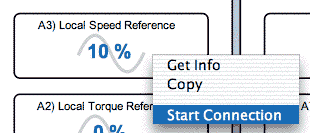Conditions
In order to make a connection from one parameter to another, several conditions must be met:
- the capability must be Engineer or higher
- the source parameter must allow outgoing connections
- the destination parameter must allow an incoming connection
- the destination parameter must not have an existing incoming connection
- the device containing the source parameter must not be locked
- the device containing the destination parameter must not be locked
If these conditions are met, you can make a connection in one of three ways: (i) via drag-and-drop, (ii) modally, or (iii) via a dialog.
Note that the PL-series DC drives use GOTO and GETFROM internal connections. These are limited in that they provide a single connection only within the drive. i.e. you cannot connect a GOTO or GETFROM to another device or to the FBE (Function Block Engine). To make an external connection from a GOTO, first connect it to another parameter, e.g. a digital or analog "post" parameter and then connect from that parameter. You can use the same technique to make an external connection to a GETFROM.
Drag and Drop Connections
To make a connection via drag-and-drop, simply drag the source parameter onto the destination parameter. For convenience, you could use a parameter Dock as a 'scratchpad' to hold parameters that you are interested in.
Modal Connections
To make a connection modally, go to the source parameter and choose 'Start Connection' from its contextual menu (in this case "Nip 2/Local Speed Reference").

Then go to the destination parameter and choose 'Make Connection from Nip 2/Local Speed Reference' from its contextual menu.

You can then go to another destination parameter and make another connection from the same source parameter, or you can go to another source parameter and choose 'Restart Connection' from its contextual menu.
Connections via a Dialog
To make a connection via a dialog, choose 'Connect To...' from the parameter's contextual menu. You will be able to choose a parameter to connect to.
Note that if you click in the 'Parameters' list (so that it has the keyboard focus), you can type in the first few characters of the parameter and the list will automatically scroll to that parameter (or the nearest match).

Rollovers and Clicking
Connections have their own rollover text: move the mouse over the parameter's connection adornment and the source or destination(s) of the connection will be shown. Clicking on the connection adornment will take you to the other end of the connection; if there are multiple possibilities, a menu will pop up.
Contextual Menu
Connections have their own contextual menu (distinct from the parameter's contextual menu). This menu allows you to get information about the parameter, change its sample period, or delete it. A parameter may have multiple outgoing connections and these are handled via hierarchical menus (see below).

